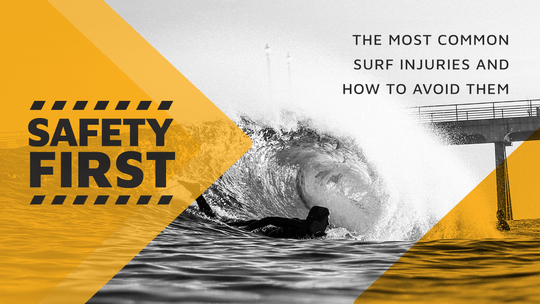Of all the potential hazards involved with surfing — the waves, the reef, other surfers, sea animals, riptides — a staggering 55% of surf injuries are caused by your own surfboard.
There’s no doubt surfing is a fun pastime, but like anything adrenaline-based, it doesn’t come without risks. Read on to find out the most common surf injuries and the best ways to avoid them.
LACERATIONS
Cuts are common surf injuries and are usually caused by the fin of your own surfboard, other boards or sharp coral reef. A scrape might not seem like a big deal. But if left untreated, a tiny laceration can turn into staph infection or Hepatitis A.
Staph infection is no joke. 119,000 people suffered from staph in 2017 and almost 20,000 died. Staph infections are caused by a bacteria called Staphylococcus, which can be deadly if it gets into your bloodstream.
Unfortunately, a laceration of any size means leaving the beach ASAP and heading to the clinic to get treatment. Luckily, there are some ways to avoid cuts and scrapes, though none of them promise to eliminate the chance completely.
Using softer fins can reduce the chance of getting cut by your own board. Wearing booties on your feet can help avoid cuts on the feet from coral.
HEAD, NECK, AND SHOULDER TRAUMA
Another risk is trauma to the head, neck, and shoulders. These injuries can be caused by hitting yourself on the head with your own board, collisions with other surfers, submerged rocks or the ocean floor.
Beginner surfers should use soft, foam boards and consider wearing a helmet. You might not look like the coolest surfer on the beach, but surfing is hard to get the hang of. There’s no shame in taking precautions when you’re just starting out.
Surfing requires a lot of paddling, which is hard on the shoulders. Before you go out, make sure you know how to paddle.
To avoid shoulder strains, stretch before you hit the waves. Most surfers are anxious to get into the water and often go without, but even 10 minutes of stretching can help to prevent rotator-cuff strains.
Get help right away if you even think you might have a concussion, or if you’re experiencing severe pain in the neck, back, face, or jaw. It could be nothing, but it could be a fracture or a severe break that requires immediate medical attention.
EYE INJURY
Another risk posed by your own board is eye injury. Surfboard tips are sharp and pointed and can cause severe eye damage. For your own safety and the safety of other surfers, use a soft nose guard on the tip of your board.
Also, whether you’re a beginner or not, try not to surf too close to anyone else. Your own board is a big enough hazard without adding someone else’s to the mix.
If you do sustain an eye injury that causes loss of vision or bleeding from the eye socket, seek treatment right away. Eye injuries left untreated can lead to permanent loss of vision.
MARINE ANIMALS
The first thing you probably thought about was sharks. While shark attacks do happen, they’re not very common. There were 53 unprovoked shark attacks in the United States in 2018, and none of them were fatal.
Jellyfish stings and stingray injuries are more common. To treat a jellyfish sting, contrary to popular belief, you don’t have to pee on it. Submerge the area in warm salt water and make sure to remove any tentacles left in the skin.
Same goes for stingray injuries. Submerge the area in hot water and go to the doctor for some antibiotics.
Unfortunately, there’s not much you can do to avoid contact with sea creatures. You are in their domain, after all. If you think you’ve been stung or bitten (you’ll know), leave the water immediately and get help.
THE TAKEAWAY: HOW TO AVOID SURF INJURIES
There are a few precautions you can take to reduce the chances of suffering any of these common surf injuries.
Prepare yourself for the water. Do your research. Stretch. Spend some time watching to make yourself aware of the environment. Use sunscreen. Wear a hat. The sun is just as dangerous as the water itself.
If you’re just starting out, take a lesson. In addition to learning the basics of the sport itself, you’ll learn common etiquette that will keep you on the good side of the locals.
We hope this helped wrap your head around how to reduce the chances of getting hurt surfing. If you’re in the San Diego area, check out our surf lessons.






